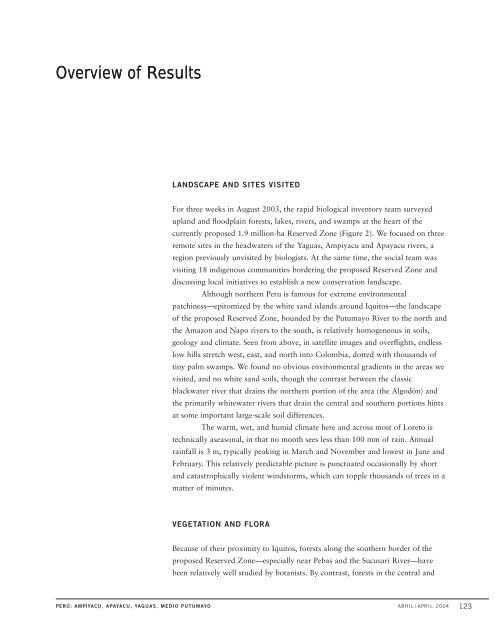12 rapid
12 rapid
12 rapid
Create successful ePaper yourself
Turn your PDF publications into a flip-book with our unique Google optimized e-Paper software.
Overview of Results<br />
LANDSCAPE AND SITES VISITED<br />
For three weeks in August 2003, the <strong>rapid</strong> biological inventory team surveyed<br />
upland and floodplain forests, lakes, rivers, and swamps at the heart of the<br />
currently proposed 1.9 million-ha Reserved Zone (Figure 2). We focused on three<br />
remote sites in the headwaters of the Yaguas, Ampiyacu and Apayacu rivers, a<br />
region previously unvisited by biologists. At the same time, the social team was<br />
visiting 18 indigenous communities bordering the proposed Reserved Zone and<br />
discussing local initiatives to establish a new conservation landscape.<br />
Although northern Peru is famous for extreme environmental<br />
patchiness—epitomized by the white sand islands around Iquitos—the landscape<br />
of the proposed Reserved Zone, bounded by the Putumayo River to the north and<br />
the Amazon and Napo rivers to the south, is relatively homogeneous in soils,<br />
geology and climate. Seen from above, in satellite images and overflights, endless<br />
low hills stretch west, east, and north into Colombia, dotted with thousands of<br />
tiny palm swamps. We found no obvious environmental gradients in the areas we<br />
visited, and no white sand soils, though the contrast between the classic<br />
blackwater river that drains the northern portion of the area (the Algodón) and<br />
the primarily whitewater rivers that drain the central and southern portions hints<br />
at some important large-scale soil differences.<br />
The warm, wet, and humid climate here and across most of Loreto is<br />
technically aseasonal, in that no month sees less than 100 mm of rain. Annual<br />
rainfall is 3 m, typically peaking in March and November and lowest in June and<br />
February. This relatively predictable picture is punctuated occasionally by short<br />
and catastrophically violent windstorms, which can topple thousands of trees in a<br />
matter of minutes.<br />
VEGETATION AND FLORA<br />
Because of their proximity to Iquitos, forests along the southern border of the<br />
proposed Reserved Zone—especially near Pebas and the Sucusari River—have<br />
been relatively well studied by botanists. By contrast, forests in the central and<br />
PERÚ: AMPIYACU, APAYACU, YAGUAS, MEDIO PUTUMAYO ABRIL/ APRIL 2004 <strong>12</strong>3

















